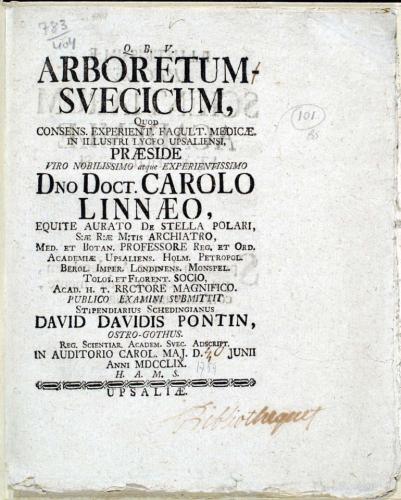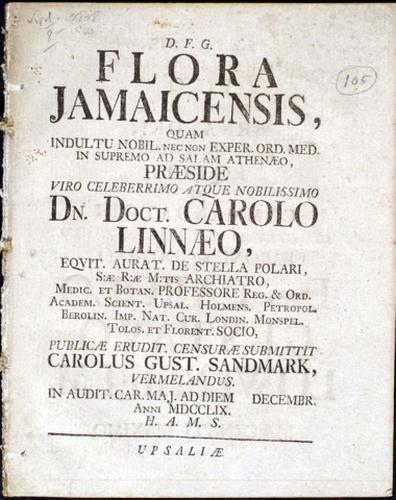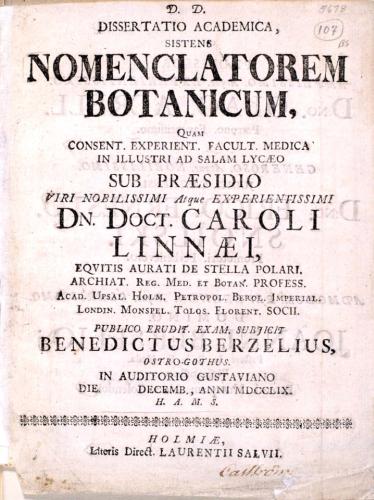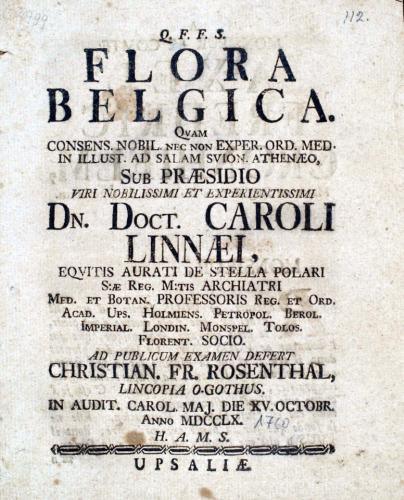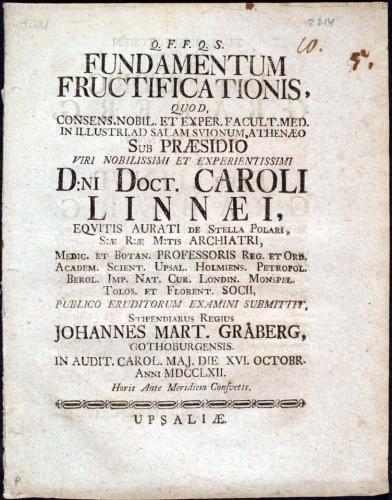Original Linnaean Dissertations - Browse
Respondent: David Davidsson Pontin (1733–1809)
Title: Arboretum Svecicum, ...
Date of Defense: {30} June 1759
Paginations: [ii], [1], 4-30
Lidén Title: Arboretum svecicum.
Soulsby Title: Arb. Svec.
Drake Title: Arboretum Svecicum.
Note: Two copies have page 28 misnumbered as 23 and day supplied in manuscript.
Abstract: An account of the growth and size of native trees of Sweden.
Respondent: Gabriel Elmgren (1730–1765)
Title: Plantarum Jamaicensium Pugillus, ...
Date of Defense: 28 November 1759
Paginations: [ii], [1], 4-31, [1]
Lidén Title: Plantarum jamaicensium pugillus.
Soulsby Title: Pl. Jam.
Drake Title: Plantarum Jamaicensium Pugillus.
Note: P. 5 unnumbered.
Abstract: An account of 130 of the more rare of the 1,200 or so species of Jamaican plants of which specimens were presented to Linnaeus by Patrick Browne. The specimens are now in the Linnaeus herbarium at the Linnean Society of London.
Respondent: Johan Schröder (1727–1764)
Title: Genera morborum, ...
Date of Defense: 5 December 1759
Paginations: [iii], [1], 5-32
Lidén Title: Genera morborum.
Soulsby Title: Gen. morb.
Drake Title: Genera Morborum.
Note: P. 6 unnumbered.
Abstract: This is Linnaeus' first published classification of human diseases, based substantially on Francois Boissier de Sauvages de la Croix's (1706-1767) Nosologia methodica sistens morborum classes … (Amsterdam, 1763), a symptomatic classification of deseases.
Respondent: Christian Ludvig Ramström (1740–1782)
Title: Generatio Ambigena, ...
Date of Defense: 12 December 1759
Paginations: [ii], [1], 2-17, [1]
Lidén Title: Generatio ambigena.
Soulsby Title: Generat. ambig.
Drake Title: Generatio Ambigena.
Note:
Abstract: An essay on sexual reproduction, with emphasis on that among animals. Study is made of the relative influence of each parent on resultant offspring, with the conclusion that external form and libido are derived largely from the male parent. Examples from both the animal and plant kingdoms are given in support of the contention.
Respondent: Carl Gustaf Sandmark (1738?–1769)
Title: Flora Jamaicensis, ...
Date of Defense: {22} December 1759
Paginations: [vi], [1], 8-27, [1]
Lidén Title: Flora jamaicensis.
Soulsby Title: Fl. Jam.
Drake Title: Flora Jamaicensis.
Note: Two copies have day supplied in manuscript; one copy lacks day.
Abstract: This work is based on specimens of some 1,200 species of Jamaican plants received by Linnaeus from Patrick Browne (1720-1790) and information on some 800 species collected by Hans Sloane (1660-1753). Linnaeus also used information in Browne's A civil and natural history of Jamaica (London, 1756) and in Sloane's A voyage to the islands Madeira... and Jamaica (London, 1707-1725).
Respondent: Johan Victor Siefvert (1738–1791)
Title: Aer habitabilis, ...
Date of Defense: 22 December 1759
Paginations: [ii], [1], 4-25, [1]
Lidén Title: Aer habitabilis.
Soulsby Title: Aer habit.
Drake Title: Aër Habitabilis.
Note:
Abstract: A medical treatise on the effects of the earth's atmosphere on health, economy, and the manners of man.
Respondent: Bengt Berzelius (1739–1777)
Title: ... sistens Nomenclatorem Botanicum, ...
Date of Defense: {24} December 1759
Paginations: [iii], [1], 7-19, [1]
Lidén Title: Nomenclator botanicus.
Soulsby Title: Nom. bot.
Drake Title: Nomenclator Botanicus.
Note: One copy has day supplied in manuscript.
Abstract: A tabular account of vernacular names of plant genera, especially those of European gardens, in Dutch, English, French, German, and Italian, equated with the Linnaean Latin name of the respective genus. Many of the vernacular names were taken from Christian Mentzel's (1622-1701) Index nominum plantarum universalis multilinguis ... (Berolini, 1682).
Respondent: Jacob Lindh (173?–1778)
Title: ... de Pingvedine Animali, ...
Date of Defense: 24 December 1759
Paginations: [vi], [1], 8-32
Lidén Title: Pingvedo animalis.
Soulsby Title: Ping. anim.
Drake Title: Pingvedine Animali.
Note:
Abstract: An essay on the natural history of swine (Sus scrofa L.), their economy and usefulness to man.
Respondent: Henric Christian Daniel Wilcke (1739–1788)
Title: ... de Politia naturae, ...
Date of Defense: 29 March 1760
Paginations: [ii], [1], 2-22
Lidén Title: Politia naturae.
Soulsby Title: Polit. nat.
Drake Title: Politia Naturae.
Note:
Abstract: An essay on the balance that exists among the three natural kingdoms, their interdependence, and the proliferation of diversity of kinds within each. The account is patterned on the plan of the dissertation Oeconomia naturae.
Respondent: Johann Christian Daniel von Schreber (1739–1810)
Title: Theses medicae, ...
Date of Defense: 14 June 1760
Paginations: [i], [1], 3-4
Lidén Title: Theses medicae.
Soulsby Title: Th. med.
Drake Title: Theses Medicae.
Note:
Abstract: An essay on the interrelationship between the anatomy and physiology of the plant, in which it is held that every higher plant is composed essentially of a medulla, the basis for which species have characters in common that unify them as a genus, and a cortex by which nutrition is supplied to the individual. Recognition is given to the presence in a genus of interspecific hybrids. Species are held to have in common certain characteristics of taste and odor. As Frans Stafleu (1921-1997) noted, "This dissertation contained the terms of Linnaeus's theory on the hierarchy of taxa" (Linnaeus and the Linnaeans, p. 145).
Respondent: Christian Emmanuel Hoppius (1736–?)
Title: ... in qua Anthropomorpha ...
Date of Defense: 6 September 1760
Paginations: [vi], [1], 2-16, 1 plate
Lidén Title: Anthropomorpha.
Soulsby Title: Anthrop.
Drake Title: Anthropomorpha.
Note:
Abstract: An account of four species of the genus Simia, considered by Linnaeus to include most apes and monkeys (restricted by later authors to the chimpanzee). Much of the data are from literature accounts, later known to be erroneous. The dissertation generated dissension among some theologians for its alliance of humans with the apes.
Respondent: Christian Fredrik Rosenthal (1740–1810)
Title: Flora Belgica, ...
Date of Defense: 15 October 1760
Paginations: [iv], [1], 2-23
Lidén Title: Flora belgica.
Soulsby Title: Fl. Belg.
Drake Title: Flora Belgica.
Note:
Abstract: Essay based on Jan Commelin's (1629-1692) Catalogus plantarum indigenarum, 1709 and David de Gorter's (1717-1783) Flora Gebro-Zutphanica, 1745-1747.
Respondent: Pehr Jerlin (1739–1773)
Title: Macellum olitorium, ...
Date of Defense: {20} December 1760
Paginations: [v], [1], 7-23, [1]
Lidén Title: Macellum olitorium.
Soulsby Title: Mac. olit.
Drake Title: Macellum Olitorium.
Note: Three copies have day supplied in manuscript; one copy has day left blank. Also, p. 8 misnumbered 6 in all four copies.
Abstract: An essay on 77 species of plants native to Sweden or commonly cultivated there and useful as culinary vegetables, providing for each: data on parts eaten, preparation for eating, taste, nutritional value, and growth duration.
Respondent: Henrik Ullmark (1740–1771)
Title: Prolepsis Plantarum, ...
Date of Defense: 22 December 1760
Paginations: [iv], [1], 2-22
Lidén Title: Prolepsis plantarum.
Soulsby Title: Prol. pl. 1760
Drake Title: Prolepsis Plantarum.
Note:
Abstract: An essay on the ontogeny of the flower, from time of bud initiation to anthesis. Linnaeus conceived the flower bud, the reproduction unit of higher plants, to be analagous with animal sexual anatomy, and held that for trees, six years were required for complete bud formation. Without supporting evidence, he adduced that in the first year medullary and cortical material are produced; in the second, the bud scales are formed; in the third, the floral cup of perianth; in the fourth, the petals; in the fifth, the stamens; and in the sixth, the pistil (gynoecium). Includes a dedication by Adam Kuhn, Linnaeus' only pupil from America.
Respondent: Jacob Printz (1740–1779)
Title: Plantae rariores Africanae, ...
Date of Defense: {22} December 1760
Paginations: [ii], [1], 4-28
Lidén Title: Plantae rariores africanae.
Soulsby Title: Pl. rar. Afr.
Drake Title: Plantae Rariores Africanae.
Note: One copy has day supplied in manuscript; two copies have day left blank.
Abstract: Describes 100 South African plants, based on a collection sent from the Cape of Good Hope. Also includes a list of African plants, intended as a supplement to the dissertation defended by Carl Henriksson Wänman, Flora Capensis.
Respondent: Eric Vigelius (1730–after 1797)
Title: Diaeta acidularis, ...
Date of Defense: 18 February 1761
Paginations: [iv], [1], 2-12
Lidén Title: Diaeta acidularis.
Soulsby Title: Diaet. acid.
Drake Title: Diaeta Acidularis.
Note:
Abstract: An essay on some human diseases and their treatment with mineral waters.
Respondent: Olof Reinhold Alander (b. 1739)
Title: ... sistens Inebriantia, ...
Date of Defense: {7 April} 1761 {1762}
Paginations: [vi], [1], 8-26
Lidén Title: Inebriantia.
Soulsby Title: Inebr.
Drake Title: Inebriantia.
Note: Two copies have day and month supplied in manuscript and year corrected in manuscript; one copy lacks day and month.
Abstract: The term "inebriant" is used in this dissertation in the broadest sense, for any drug that was known to be a narcotic or intoxicant. The thesis is an account of both natural and artificial intoxicants.
Respondent: Henric Sparschuch (1742–1786)
Title: ... in qua Potus Coffee leviter adumbratur, ...
Date of Defense: 16 December 1761
Paginations: [ii], [1], 2-18, 1 plate
Lidén Title: Potus coffeae.
Soulsby Title: Pot. coff.
Drake Title: Potus Coffeae.
Note:
Abstract: A medico-botanical study of coffee as a beverage, of the coffee plant (Coffea arabica L.), and of the harvesting and preparation of coffee beans. An historical review of the use of the beverage is given, noting that Europe's first "coffee house" was opened in Marseilles in 1671. The preparation of different kinds of coffee, utilizing many other ground seeds as flavorants, is described.The account treats it to be more important for medicinal usage than as a beverage, noting it to be an anti-aphrodisiac, noxious to mental illnesses, and responsible for excessive flatulence and indigestion (allegedly sometimes fatal) when ingested to excess. Linnaeus reported that headaches are frequently relieved by drinking coffee.
Respondent: Johan Gustaf Acrel (1741–1801)
Title: ... de Morsura Serpentum, ...
Date of Defense: 16 June 1762
Paginations: [iv], [1], 2-19, [1] (1 figure)
Lidén Title: Morsura serpentum.
Soulsby Title: Mors. serp.
Drake Title: Morsura Serpentum.
Note:
Abstract: A medico-zoological study of venomous snakes and snakebite poisoning. The skeletal and muscular anatomy of snakes' heads are discussed and figured. The symptoms of snakebites are given for many species, together with treatments for same. The uses of strychine and Polygala senega as antidotes, as well as olive oil, are documented.
Respondent: Johan Elmgren (1740–1794)
Title: Termini Botanici, ...
Date of Defense: 22 June 1762
Paginations: [iii], [1], 5-32
Lidén Title: Termini botanici.
Soulsby Title: Term. bot.
Drake Title: Termini Botanici.
Note:
Abstract: A classified glossary, with explanatory notes, of 673 latin terms used by Linnaeus in his plant descriptions. The work, which was the first of its kind, was widely translated and re-published.
Respondent: Johan Peter Falck (1733–1774)
Title: Planta Alströmeria, ...
Date of Defense: 23 June 1762
Paginations: [iii], [1], 5-16, 1 plate
Lidén Title: Planta Alströmeria.
Soulsby Title: Pl. Alstr.
Drake Title: Planta Alströmeria.
Note:
Abstract: Linnaeus received seed of this Chilean plant, Alstroemeria ligtu L., from Claes Alströmer, who sent it from Cadiz, Spain.
Respondent: Birger Martin Hall (1741–1814)
Title: ... sistens Nectaria Florum, ...
Date of Defense: 25 June 1762
Paginations: [ii], [1], 2-16
Lidén Title: Nectaria florum.
Soulsby Title: Nect. fl.
Drake Title: Nectaria Florum.
Note:
Abstract: An essay on the presence, kinds and functions of nectar glands in flowers. It is the first detailed report on the subject and it gives examples of plants having the various kinds of nectaries.
Respondent: Johan Martin Gråberg (1741–1793)
Title: Fundamentum Fructificationis, ...
Date of Defense: 16 October 1762
Paginations: [iv], [1], 2-24
Lidén Title: Fundamentum fructificationis.
Soulsby Title: Fund. fr.
Drake Title: Fundamentum Fructificationis.
Note: Two copies have spelling of 'stiperdiarus' corrected in manuscript to 'stipendiarius'.
Abstract: An essay on the morphology of all floral parts and organs, with a review of their concepts and terminology by pre-Linnaean authors.
Respondent: Knut Augustin Lenaeus (1738–1799)
Title: ... de Meloë vesicatorio, ...
Date of Defense: 20 {22?} December 1762
Paginations: [iv], [1], 2-15, [1]
Lidén Title: Meloe vesicatoria.
Soulsby Title: Meloë
Drake Title: Meloë Vesicatorio.
Note: Two copies have a title page dated 20 December 1762; one of these copies also has an additional title page dated 22 December 1762.
Abstract: A study of European vesicatory (blister-producing) insects having the properties of the Cantharides fly, chiefly the blistering fly (Meloe cichorii). The report describes the insects, hosts and habitats and includes prescriptions for the use of vesicating plasters.
Respondent: Johan Martin Reftelins (Reftelius) (1740–1799)
Title: Reformatio Botanices, ...
Date of Defense: 18 December 1762
Paginations: [iv], [1], 2-21, [2]
Lidén Title: Reformatio botanices.
Soulsby Title: Reform. bot.
Drake Title: Reformatio Botanices.
Note: P. 20 misnumbered 22 in two of four copies.
Abstract: A treatise on botanical history, divided into three periods: (1) post-Renaissance, (2) that of the pre-Linnaean systematists, and (3) under the aegis of Linnaeus. The third period received the most attention. Here Linnaeus cited (as of 1762) those of his pupils who travelled to foreign lands, and the contemporary writers who adopted his system of classification in their works.

